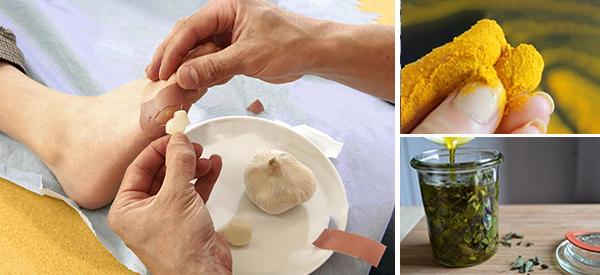
3 Home Remedies for Skin Fungus That Actually Work
Fungal skin infections are not uncommon and include athlete’s foot, ringworm, yeast infections, and those that affect the nails on hands and feet. Fortunately, most of these conditions can usually be treated easily if they are mild.
For those who prefer to avoid preparations that contain chemicals and are dealing with a mild fungal skin condition, there are several natural, DIY, or home remedies that you can use.
Oregano Infused Oil
Many of us are familiar with this herb and use it in our cooking. What you might not know is that it is a potent anti-fungal. Studies show that it works against some candida yeast strains which cause a range of skin infections.
It’s important to note, however, that there are two types of oregano oil: essential oil and infused oil. We are only discussing infused oil as an essential oil is not recommended for this application unless it is correctly diluted because it is powerful.
Ingredients:
- Chopped, crushed, or ground oregano leaves, preferable wild oregano (Origanum Vulgare)
- Olive, grape seed, or almond oil
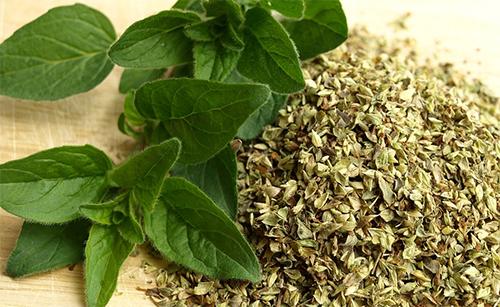
You can use fresh leaves, but they must be allowed to dry out completely first. If there is moisture in the leaves it will be introduced into the oil which may become moldy or rancid. It is better – and easier – to use dried oregano. In addition, sweet almond oil is a good choice as it has a non-greasy feel and absorbs quickly.
Method 1:
- Place the dried herb into a sterilized jar or jars so that the jar is approximately two thirds full
- Fill the jar with oil so that the oregano is saturated, and the oil level is about 1 inch or 2 centimeters above the level of the herb
- Stand the jar inside a pot but on top of a silicone mat, trivet, or cloth. Placing it directly onto the pot’s cooking surface may cause the glass to overheat and break
- Pour boiling water into the pot until the jar is half or three quarters submerged, taking care not to get water in the jar
- Turn the heat to low and leave the oil and herb mix to infuse for a minimum of four hours, stirring occasionally
- Remove the jar from the pot and strain the oil to remove all the plant matter
- Pour the strained, infused oil into a clean and sterilized jar
- Add a few drops of grapefruit seed essential oil (from a health shop). This acts as a preservative and extends the shelf life of the infusion
- Tighten the lid on the jar and label it with the date and name of the oil/infusion
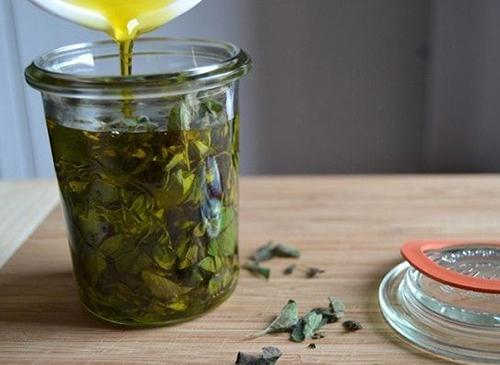
Method 2:
- With this method, the jar of herb and oil mixture is only left in a hot water bath for a short period (less than 30 minutes)
- The jar is then removed, covered with a lid, labeled, and placed on a windowsill or shelf where it will get sun for 2 weeks
- The jar should be shaken every few days
- At the end of the two weeks, strain the oil into a clean and sterile jar
- Add grapefruit seed essential oil
- Place the lid on the jar tightly, label it, and store it in the fridge or in a dark, cool area.
How to use oregano oil:
- Apply a small amount of oil to the affected area using a piece of clean cotton wool or something similar
- Gently rub the oil into the skin
- Apply the oil up to three times a day.
Storage and shelf-life:
Jars of oil can be kept in a cool, dark place. However, it is best to store your oregano oil in the fridge as this will further extend its life.
If you used fresh herbs, the infused oil’s shelf-life will be 3 to 4 weeks. It should be thrown away after that or even earlier if it appears to be going rancid (has a bad odor and/or is cloudy) or becomes moldy.
The oil that was infused with dried herbs and that had grapefruit seed essential oil added to it will last for 1 to 2 years if correctly stored.
Garlic
Like oregano, garlic is a common ingredient in our kitchens and in the food we eat. Many people are also aware that this vegetable has many health benefits. One of them is its antifungal properties which make it ideal to treat several kinds of fungal-related skin problems.
The downside is, of course, that the smell of garlic can be a little overwhelming. This can be overcome by ingesting garlic in food or in pill or capsule form rather than using it topically. However, many believe that the benefits are greater, and improvements occur faster if the garlic is applied directly to the affected area.
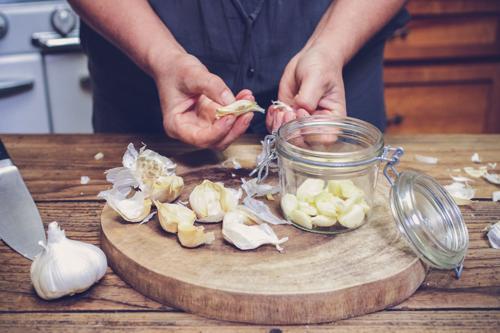
Ingredients:
- 6 – 7 heads or bulbs of fresh garlic
- ½ teaspoon of the sea, Kosher, or any coarse grain salt (optional)
- Good quality olive, almond, or coconut oil
- ¼ cup / 60 ml fresh lemon juice
Method:
- Separate the garlic into cloves
- Peel the cloves. You can use the flat side of a knife to gently crush each clove. This loosens the skin and makes peeling easier
- Mince the peeled garlic. You can use a garlic press but chopping it with a knife is preferable. Take your time and cut it into slices before dicing it smaller and smaller
- Add the salt. This is not for flavor, but it helps to break down the garlic and draws out the liquid. This in turn makes the paste much smoother. The paste will work without salt; it will just take you longer to get it smooth
- Use the edge of a good, sharp knife, at a 300 angle, to crush the garlic mixture. Alternate crushing with further chopping until you have a smooth paste.
- Place the paste into a bowl
- Add the lemon juice (it improves the smell) and mix it into the paste
- Add as much oil as is necessary to make the paste smooth and a good consistency (not too liquid).
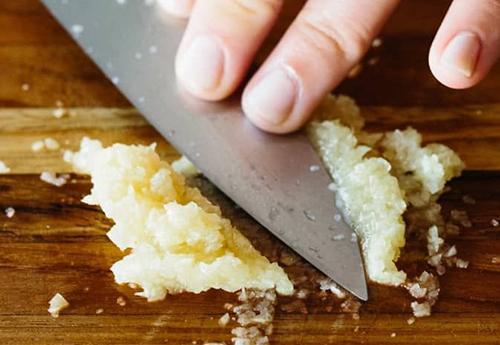
If you have a blender you can use it to create a paste instead of using a knife. Simply peel the garlic and place it and the other ingredients into the blender. Do not overdo it as you may end up with garlic juice rather than paste!
How to use garlic paste:
- Use a cotton ball or other suitable material to apply a small amount of paste to the affected skin. It should be just enough to create a thin coat on the skin.
- Leave the paste on for a maximum of two hours
- Rinse the paste off gently using warm water
- Repeat the application twice a day until the fungal infection is showing improvement.
Caution: Do not apply the garlic paste onto your skin unless you have mixed it with oil because raw, pure garlic can cause severe skin irritation.
Storage and shelf-life:
Home-made garlic paste must be stored in an airtight jar that is clearly labeled and dated.
Store the paste in a refrigerator where it will keep for up to 30 days. If you want to extend the shelf-life, store the container in the freezer. However, it must be used once it has been defrosted as it is not a good idea to repeatedly re-freeze it.
Turmeric
Turmeric has been used for centuries in food. However, it is only recently that we in the West have discovered that this bright yellow spice offers a range of health benefits. One of these is its antifungal properties.
You can use turmeric as a seasoning in your food, as a tea, or take capsules. If you are treating fungal skin infection, though, it will be far more effective if you apply it to the affected skin directly.
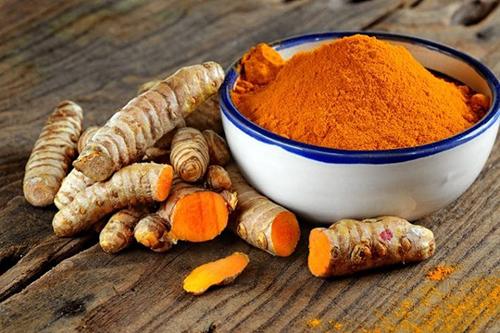
Ingredients:
- 1-part turmeric powder
- 2-parts water OR olive, almond, or coconut oil
Method:
- Mix the turmeric powder with the oil or water
- Place the mixture in a saucepan, and simmer it over low heat until it forms a paste
- Place the paste into a sterilized jar with a lid and label it
- Allow the mixture to cool.
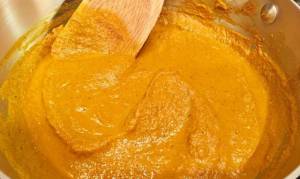
How to use turmeric paste:
- Gently apply the cool paste to the affected area
- Cover the area you have treated with paste with a gauze bandage or dressing
- Leave the paste on as long as possible or overnight
- Remove the covering and rinse the skin with warm water
- Pat the skin dry.
Note: Turmeric may make your skin yellow, but it is temporary and will fade with washing and after a few days of stopping the application.
If you don’t like the idea of a paste, you can make turmeric tea. Use 1 teaspoon of turmeric to 4 cups of water. Bring the water to a boil, simmer the tea for 10 minutes. You can add honey, ginger, or lemon to the tea if you find they improve the taste.
Storage and shelf-life:
Turmeric paste must be stored in an airtight glass jar in the fridge. The shelf-life for this preparation is only two weeks.
There are other options you could consider. For example, coconut oil works on mild infections but is not inexpensive, or you could opt for a mixture of tea tree and coconut oils which can also be a little costly.
Although these fungal skin problems are common, they shouldn’t be ignored. Some of these infections can become quite serious and require medical intervention. If an infection is not improving or is getting worse, seek advice from a health care professional.
You may also like:
 How to Make Your Own Turmeric Drops
How to Make Your Own Turmeric Drops
I Stopped Spending Money At The Pharmacy By Growing These 10 Plants (Video)
Backyard Plants You Can Use For Skin Rashes








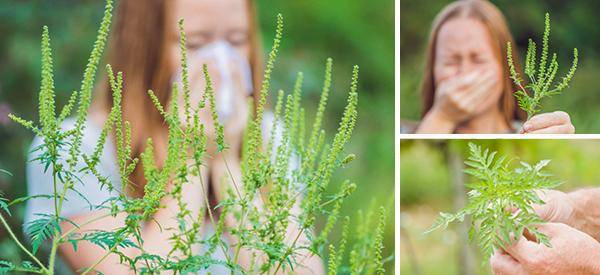
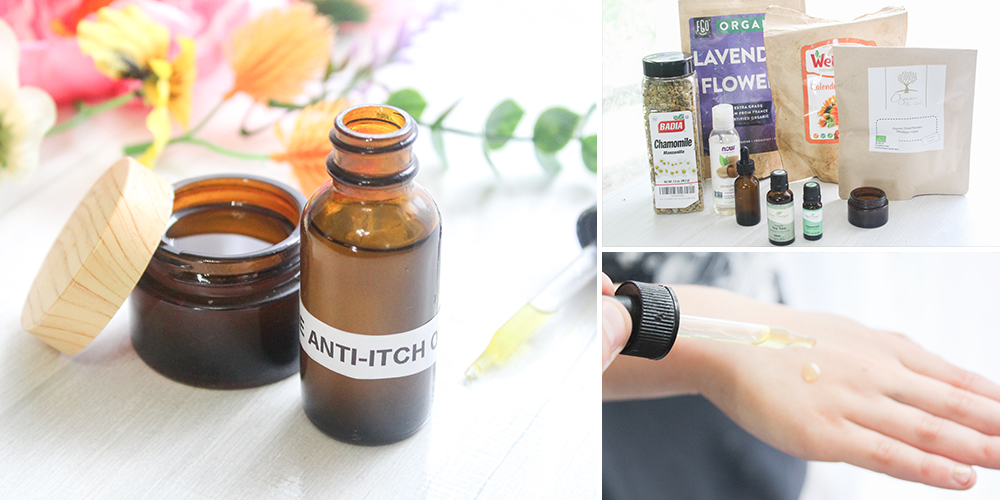
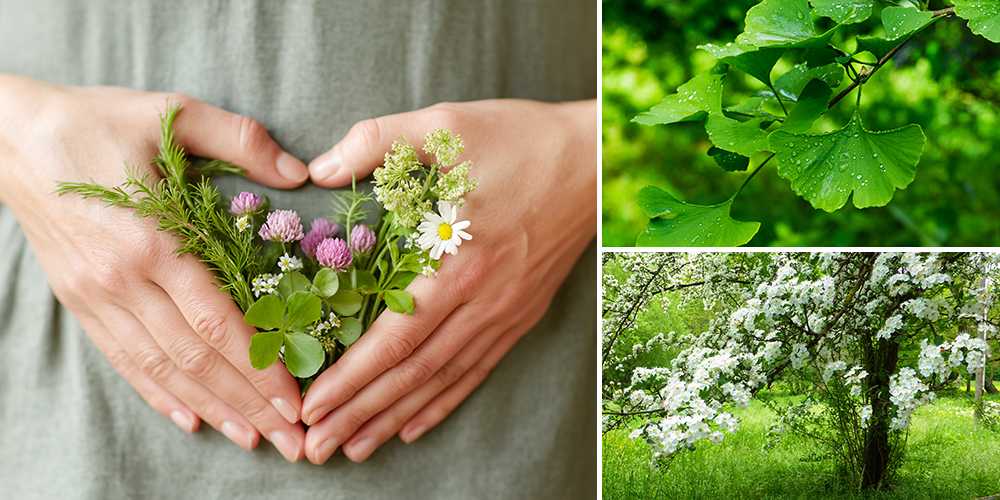
Which of these would be best to use on the fungus that affects nails?
garlic is what I prefer. seems to work for me
Hi Al Ames,
Thank you so much for your comment.
It depends on the person’s physiology.
You can firstly try Turmeric or Garlic. As far as I know, garlic is one of the most used and beneficial of all.
God bless!
Which of these would be best to use on the fungus that affects nails?
Hi Caroline,
Thank you so much for your comment.
I advise you to use garlic. It is the most used and beneficial of them all.
God bless!
My fungus is in the groin area! It creates in grown hairs, that are hard to remove! The fungus came, from a home, that the pipe to the septic tank and sewage leaked under the house and the walls were covered in black mold! Not realizing, the danger of the mold! I tried cleaning it and got some into an oped wound on my body! That’s where my fungus came from! Black Mold!
Hi Johnny,
Thank you so much for your comment.
I was not aware that fungus can be contacted this way as well.
I wish you the best health!
God bless!
This was my grandmother’s fortè traditional Native American herbal medicine, too bad my mother abandoned this tradition and re(lies) on big pharma! I’ve started reading this info to her at her tender age of 103 years!
Hi Wahchaxi,
Thank you so much for your comment.
This is amazing! I hope she is enjoying the healing power of herbs.
God bless!
If your mother is 103 her long life is probably due to her mothers herbal medicine as a child. Or is your Grandmother who is now 103? Either one…. thanks to natural remedies 🙂
my mom had chronic athlete’s foot for 2 years. her entire foot was raw. doc tried everything. I mixed turmeric and bread soda for her. she ruined many socks but it cleared in a month. she applied it as a foot powder twice a day. magic.
Hi Marian,
Thank you so much for your comment.
Turmeric’s healing powers are indeed amazing!
God bless!
Would it be wise to add garlic powder to this powder? Would that make it a more effective healing agent or am I getting carried away her? Thx
I have Meniere’s disease, is there anything I could use to help stop the fluid buildup and the ear aches and headaches. I can’t hear from my right ear and about 1/2 in my left.
Of course it keeps you off balance and dizzy.
Meniere’s disease might me a response for a compromised immune system so you might want to add to your diet some of the nature’s immune boosters like: Hops, Turmeric, Sarsaparilla, Nettle, Green tea and Ginger.
Also reduce your salt and sugar intake and avoid caffeine.
Specially for the dizziness you can take 1 tablespoon of coriander seeds and soak them in water along with 1 tablespoon of gooseberry powder. Do this in the night and strain it in the morning. After straining, add half tablespoon of sugar and drink it right away.
God bless!
I’m going to boil a yellow dock leaf and then use that water with some coconut oil and turmeric to make a paste for a toe that I believe has a fungal infection.
Anything for osteoarthritis?
why not add some turmeric to the garlic paste prepartion?